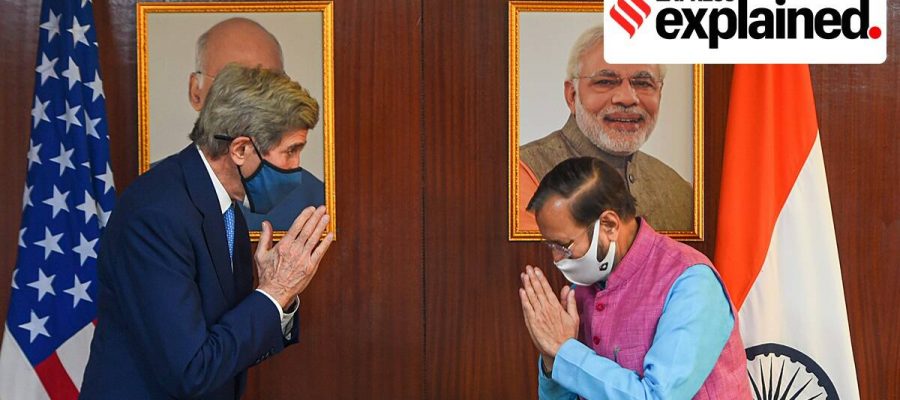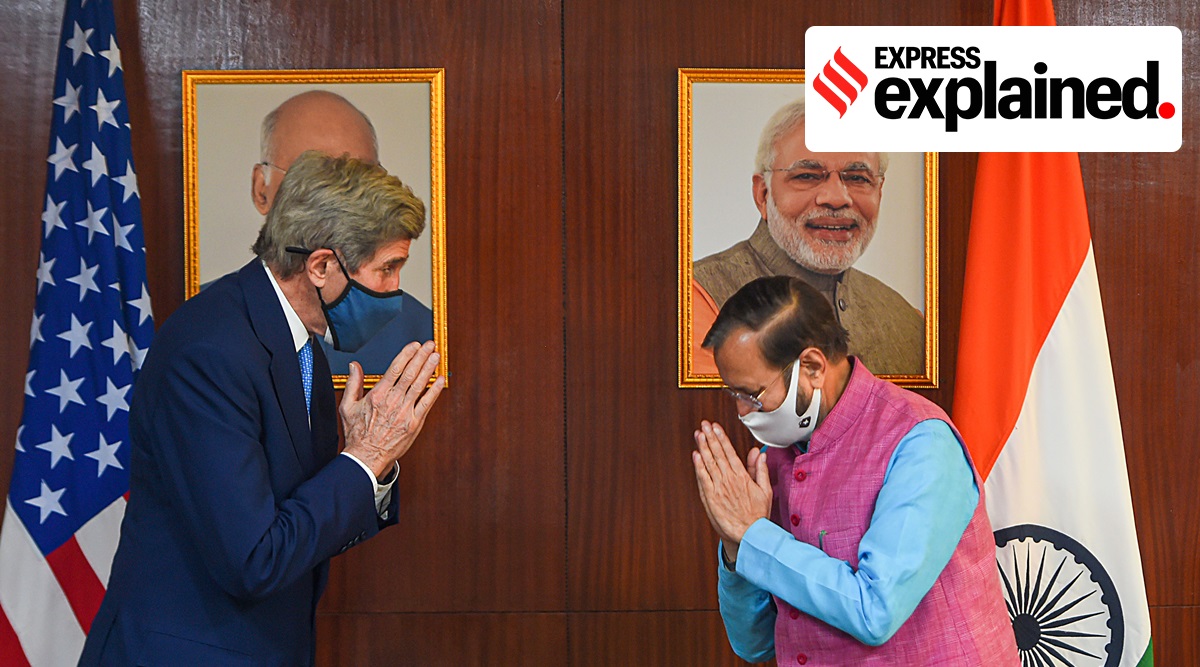US President’s Climate Envoy is in India. One point of discussion could be the net-zero goal for 2050, which the US wants India to be on board on. What is net-zero, and what are India’s objections?
Get email alerts for your favourite author. Sign up here
John Kerry, the US President’s Special Envoy on Climate, is currently on a three-day visit to India trying to rekindle a climate change partnership that had been all but put on hold during the four years of the Donald Trump administration. The immediate purpose of the visit is to exchange notes ahead of the virtual Climate Leaders’ Summit convened by US President Joe Biden on April 22-23 where Prime Minister Narendra Modi is one of the invitees. This is Biden’s first big international intervention in climate change, and his administration would be keen to ensure a substantive outcome from it.
Newsletter | Click to get the day’s best explainers in your inbox
In its bid to reclaim the global climate leadership, the US is widely expected to commit itself to a net-zero emission target for 2050 at the summit. Several other countries, including the UK and France, have already enacted laws promising to achieve a net-zero emission scenario by the middle of the century. The European Union is working a similar Europe-wide law, while many other countries including Canada, South Korea, Japan and Germany have expressed their intention to commit themselves to a net-zero future. Even China has promised to go net-zero by 2060.
India, the world’s third biggest emitter of greenhouse gases, after the US and China, is the only major player holding out. One of the objectives of Kerry’s visit is to explore whether New Delhi can be nudged to drop its hard opposition, and open up to the possibility of pledging itself to a 2050 net-zero goal.
The net-zero goal
Net-zero, which is also referred to as carbon-neutrality, does not mean that a country would bring down its emissions to zero. Rather, net-zero is a state in which a country’s emissions are compensated by absorption and removal of greenhouse gases from the atmosphere. Absorption of the emissions can be increased by creating more carbon sinks such as forests, while removal of gases from the atmosphere requires futuristic technologies such as carbon capture and storage.
This way, it is even possible for a country to have negative emissions, if the absorption and removal exceed the actual emissions. A good example is Bhutan which is often described as carbon-negative because it absorbs more than it emits.
A very active campaign has been going on for the last two years to get every country to sign on to a net-zero goal for 2050. It is being argued that global carbon neutrality by 2050 is the only way to achieve the Paris Agreement target of keeping the planet’s temperature from rising beyond 2°C compared to pre-industrial times. Current policies and actions being taken to reduce emissions would not even be able to prevent a 3–4°C rise by the turn of the century.
The goal of carbon neutrality is only the latest formulation of a discussion going on for decades, on having a long-term goal. Long-term targets ensure predictability, and continuity, in policies and actions of the countries. But there has never been a consensus on what this goal should be.
Earlier, the discussions used to be on emission-reduction targets, for 2050 or 2070, for rich and developed countries, whose unregulated emissions over several decades are mainly responsible for global warming and consequent climate change. The net-zero formulation does not assign any emission reduction targets on any country.
Theoretically, a country can become carbon-neutral at its current level of emissions, or even by increasing its emissions, if it is able to absorb or remove more. From the perspective of the developed world, it is a big relief, because now the burden is shared by everyone, and does not fall only on them.
India’s objections
India is the only one opposing this target because it is likely to be the most impacted by it. India’s position is unique. Over the next two to three decades, India’s emissions are likely to grow at the fastest pace in the world, as it presses for higher growth to pull hundreds of millions of people out of poverty. No amount of afforestation or reforestation would be able to compensate for the increased emissions. Most of the carbon removal technologies right now are either unreliable or very expensive.
But on principle as well as practice, India’s arguments are not easy to dismiss. The net-zero goal does not figure in the 2015 Paris Agreement, the new global architecture to fight climate change. The Paris Agreement only requires every signatory to take the best climate action it can. Countries need to set five- or ten-year climate targets for themselves, and demonstrably show they have achieved them. The other requirement is that targets for every subsequent time-frame should be more ambitious than the previous one.
Implementation of the Paris Agreement has begun only this year. Most of the countries have submitted targets for the 2025 or 2030 period. India has been arguing that instead of opening up a parallel discussion on net-zero targets outside of the Paris Agreement framework, countries must focus on delivering on what they have already promised. New Delhi is hoping to lead by example. It is well on its way to achieving its three targets under the Paris Agreement, and looks likely to overachieve them.
Several studies have shown that India is the only G-20 country whose climate actions are compliant to the Paris Agreement goal of keeping global temperatures from rising beyond 2°C. Even the actions of the EU, which is seen as the most progressive on climate change, and the US are assessed as “insufficient”. In other words, India is already doing more, relatively speaking, on climate than many other countries.
New Delhi also repeatedly points to the fact that the developed nations have never delivered on their past promises and commitments. No major country achieved the emission-cut targets assigned to them under the Kyoto Protocol, the climate regime preceding the Paris Agreement. Some openly walked out of the Kyoto Protocol, without any consequences. None of the countries has delivered on the promises they made for 2020. Even worse is their track record on their commitment to provide money, and technology, to developing and poor countries to help them deal with the impacts of climate change.
India has been arguing that the 2050 carbon-neutrality promise might meet a similar fate, although some countries are now binding themselves in law. It has been insisting that the developed countries should, instead, take more ambitious climate actions now, to compensate for the unfulfilled earlier promises.
At the same time, it has been saying that it does not rule out the possibility of achieving carbon-neutrality by 2050 or 2060. Just that, it does not want to make an international commitment so much in advance.
Source: Read Full Article



